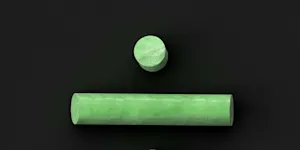What Makes This Word Tick
"Alabaster" immediately conjures images of elegance and purity. The word refers to a fine-grained, translucent form of gypsum, often used in sculptures and decorations. Its smooth texture and milky appearance have made it a favorite material throughout history, appreciated not only for its beauty but also its ability to gently diffuse light.
If Alabaster Were a Person…
If alabaster were to transform into a human, it might be that serene and graceful individual who glides through a room, emanating calm and sophistication. Their presence is subtle yet undeniably captivating, the kind of person who speaks softly but with words that linger long after they've been spoken.
How This Word Has Changed Over Time
Originally deriving from the Latin "alabaster" and Greek "alabastros," the word has maintained a fairly consistent meaning over the years. Historically, it primarily referred to the material used for crafting intricate vessels and sculptures. Today, it's also used metaphorically to describe things that are smooth and pale, like certain types of skin.
Old Sayings and Proverbs That Use Alabaster
While there may not be age-old proverbs featuring "alabaster," the term has often been poetically employed to describe purity and beauty. It's the kind of word you'd find nestled in an old sonnet praising one's "alabaster brow" or complexion.
Surprising Facts About Alabaster
Did you know that alabaster has been found in the tombs of ancient Egyptian pharaohs, used to craft intricate canopic jars and other decorative pieces? Despite its delicate appearance, alabaster has been employed in sturdy architectural elements, and some have even used it as a material for light fixtures due to its ability to beautifully diffuse light.
Out and About With This Word
Keep an eye out for alabaster in religious or historic buildings where it might feature as part of a grand window or as intricate decorative paneling. Museums also often have alabaster artifacts, giving you a closer look at its time-honored use in art and decoration.
Pop Culture Moments Where Alabaster Was Used
Alabaster has made its way into modern culture, often as a descriptor in song lyrics, literature, and film to evoke a sense of timeless beauty or refined elegance. It's one of those words that, when dropped into conversation, instantly classies it up.
The Word in Literature
Authors might use "alabaster" to set a scene dripping with opulence or to describe a character's fair complexion. Classic and contemporary literature alike love this word for its inherent ability to evoke an aura of classic beauty and sophistication.
Moments in History with Alabaster
Imagine King Tutankhamun's tomb, discovered with alabaster canopic jars to hold his treasures for the afterlife. This illustrates how alabaster has long been associated with luxury and rites of passage, making it part of some spectacular archaeological finds throughout history.
This Word Around the World
Its use transcends borders, but what's fascinating is how various cultures have utilized alabaster. In Italy, the city of Volterra is famous for its alabaster. In contrast, the ancient Egyptians used it for religious artifacts. Even today, you might find various cultural interpretations and uses of alabaster in art and design.
Where Does It Come From?
Alabaster has classical roots, stemming from the Middle English "alabastre," which in turn came from the ancient Greek "alabastros." These historical origins reflect its long-standing association with beauty and artistry.
How People Misuse This Word
Sometimes people use "alabaster" to simply mean the color white, but its true essence lies in its textural qualities and historical context. It's not just any kind of white; it's that particular ethereal, glowing hue you find in certain works of art and architecture.
Words It’s Often Confused With
Marble: Often confused due to both being used in sculptures, but marble is stone while alabaster is a form of gypsum.
Ivory: Similar appearance but ivory comes from animal tusks, whereas alabaster is mineral-based.
Porcelain: Another smooth, white material, but it's clay-based and often used in pottery, unlike stone or gypsum-based alabaster.
Additional Synonyms and Antonyms
Synonyms for alabaster include "milky," "translucent," and "smooth." Antonyms could be "rough," "opaque," and "dull," speaking to its opposite in texture and appearance.
Want to Try It Out in a Sentence?
"The artist lovingly shaped the alabaster into a delicate figurine, its pearly finish gleaming under the soft museum lights."
















